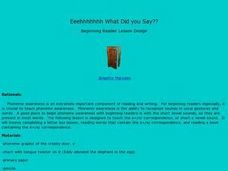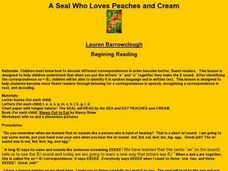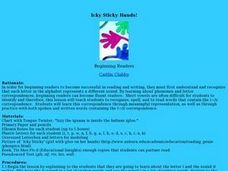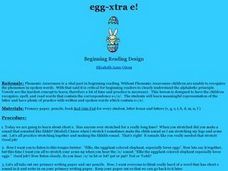Curated OER
Pooh's Rumbling Tummy
Students recognize the short vowel u in written and spoken language. Through matching and listening activities, they discriminate the vowel sound /u/ from other phonemes. Students identify the phoneme and letter in words and pictures.
Curated OER
Scary Scary....aaaaa!!!
Students study the /a/ in both written and spoken word by reciting a tongue twister in which they exaggerate the /a/. Next, the make given words using letterboxes after the teacher models the technique, Next, they read "Pat's Jam" to a...
Curated OER
Shelly Shark Goes Shopping
Students identify the digraph /sh/ in written and spoken language. Students practice the production of the /sh/ sound through words and tongue twisters. They identify the initial and final placement of the new digraph /sh/ through...
Curated OER
Say What?
Learners explore phonemes in spoken words. They discuss the /e/ (short e) correspondence. Students read "Red Gets Fed." They learn a meaningful letter symbol for the /e/. Learners identify /e/ sound in both spoken and written words.
Curated OER
"Loud Cows All Around"
Young scholars practice with vowel digraphs and how letters can correspond with phonemes. The lesson consists of students learning the ou=/ow/ correspondence in which they will learn in both spoken and written words through reading and...
Curated OER
Ow! That Hurts!
Young scholars identify the diagraph of ow coming together to make one sound. They read words containing this diagraph and spell words too. In the story, The Napping House, each pair of students finds -ow words. As an assessment,...
Curated OER
"OU" O U Hurt Me!
Learners explore the digraph ou=/ow/ in written and spoken words. They practice writing words with the ou=/ow/ digraph. Students match phonemes in words they hear. Learners read The Napping House and identify words with the ou=/ow/ digraph.
Curated OER
Howwwwl At The Moon
Students explore vowel digraphs. They discuss what a vowel digraph is and discuss the vowel digraph ou=/ow/. Students read "The Napping House." They practice spelling words with the /ow/ sound in them. Students read words with the /ow/...
Curated OER
Eeehhhhhhh What Did you Say??
Student read pseudo words containing the e=/e/ correspondence and recognize sounds in vocal gestures and words. They explore the e=/e/ correspondence, or short e vowel sound and complete a letter box instructional activity, reading...
Curated OER
Unopened Umbrella
Students explore vowel correspondences. They discuss the vowel correspondence u=/u/. They identify u=/u/ in written words and a meaningful representation and letter symbol for the sound. Students read and write words using u=/u/.
Curated OER
Shiny Shells on the Shore
Students investigate how: A single phoneme, which is a vocal gesture in spoken words, can be represented by more than one grapheme. Also how a digraph is the combination of two letters that make one sound (there are both vowel and...
Curated OER
A Seal Who Loves Peaches and Cream
Students decode correspondence in order to become better, fluent readers. When the letters e and a are put together they make the E sound. They become more fluent readers through listening for a correspondence in speech, in text, and...
Curated OER
U-u-under The U-u-umbrella!
Young scholars practice using phonemes because they need to be able to recognize that phonemes and letters correspond with each other in order to become a proficient reader. The practice is done using the letter "u".
Curated OER
Opera Singer
Students recognize the short vowel o in written and spoken language. Through listening and decoding activities, they discriminate the vowel sound /o/ from other phonemes. Students identify the phoneme and letter in pseudo words they read.
Curated OER
O-O-O-O-O, I get it!
Students engage in an emergent literacy instructional activity that focuses on the skill of phonemic awareness. To practice the skill the phoneme for the letter "o" is used. The students need to recognize the letter and its corresponding...
Curated OER
Icky Sticky Hands!
Students examine the letter 'i'. Through instruction and modeling they explore the sound the letter makes, how the letter is written, words that contain the letter, etc. They use letterboxes to write 'i' words and read stories containing...
Curated OER
Icky Stinky Fingers!
Students examine the letter 'i'. Through instruction and modeling they explore the sound the letter makes, how the letter is written, words that contain the letter, etc. They use letterboxes to write 'i' words and read stories...
Curated OER
Icky Fingers
Students are introduced to digraphs so they can match letters to their phonemes. They recognize the short vowel i=/i/ in both spoken and written words by practicing reading and spelling words containing /i/. Elkonin Letter Boxes are...
Curated OER
Shhhhelly Shhhhrimp
Students read and spell words via alphabetic insight that letters stand for phonemes and spelling. They map out the phonemes in spoken words. This lesson will help students identify the letters s and h, along with the sound...
Curated OER
Uhh I don't know!
Learners engage in an emergent literacy lesson in order to work on the skill of phonem ic awareness. The use of flashcards is essential for the instruction of the lesson. Students match the card with its beginning phoneme.
Curated OER
Cat Nap
Students identify and interpret the concept of the vowel /a/ and recognize it in words and illustrations. They also practice writing both upper and lower case A on writing paper. Finally, students name pictures and circle the pictures...
Curated OER
Egg-xtra E!
First graders recognize the short vowel e in written and spoken language. Through listening activities, they discriminate the vowel sound /e/ from other phonemes. Students identify the phoneme and letter in words and sentences they write.
Curated OER
Bless You
Students practice recognizing the phoneme /a/ in spoken and written words as well as by symbol. They interact with the book, "The Cat Nap," from Educational Insights and the Dr. Seuss book, "ABC's Book." Each student also plays a memory...
Curated OER
Eddie the Elephant
Students need to practice sight words to become proficient readers. So it is very important for children to learn common correspondences. The phoneme for the letter "e" is practiced in this lesson.

























